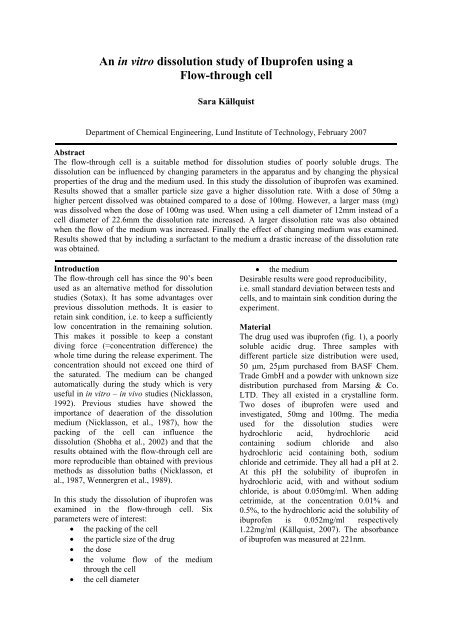A dissolution study of Ibuprofen in a flow-through-cell
A dissolution study of Ibuprofen in a flow-through-cell
A dissolution study of Ibuprofen in a flow-through-cell
- No tags were found...
Create successful ePaper yourself
Turn your PDF publications into a flip-book with our unique Google optimized e-Paper software.
302520reach saturation at start with neither <strong>of</strong> thedoses but s<strong>in</strong>k condition was not establisheddespite this fact.% Upplöst15105050mg100mgWhen chang<strong>in</strong>g the <strong>cell</strong> diameter from 22.6mmto a smaller one, 12mm, the <strong>dissolution</strong><strong>in</strong>creased (fig. 6).0 50 100 150 200Tid (m<strong>in</strong>)60Figure 4. Percentage dissolved ibupr<strong>of</strong>en, 50µm,<strong>in</strong> hydrochloric acid us<strong>in</strong>g the <strong>flow</strong>-<strong>through</strong>-<strong>cell</strong>,22.6mm <strong>cell</strong> and volume <strong>flow</strong> 8ml/m<strong>in</strong>, two doses,50mg and 100mg.% Upplöst504030201012mm22.6mmThe smaller dose gave a higher <strong>dissolution</strong>percent (fig 4). The reason is that the massratio between drug dosage and glass beads ischanged when the dose is altered. When thesmaller dose was used the particles wherebetter separated result<strong>in</strong>g <strong>in</strong> a better wett<strong>in</strong>g <strong>of</strong>each particle. However when compar<strong>in</strong>g themass (mg) dissolved the larger drug dose gavea higher value (fig. 5).25201510500 50 100 150 200Tid (m<strong>in</strong>)100 mgFigure 5. Mass dissolved ibupr<strong>of</strong>en, 50µm <strong>in</strong>hydrochloric acid us<strong>in</strong>g the <strong>flow</strong>-<strong>through</strong>-<strong>cell</strong>,22.6mm <strong>cell</strong>, volume <strong>flow</strong> 8ml/m<strong>in</strong>, two doses,50mg and 100mg.This can be expla<strong>in</strong>ed by the samplesconta<strong>in</strong><strong>in</strong>g different amounts <strong>of</strong> f<strong>in</strong>e particlesthat has a fast <strong>dissolution</strong> rate. They both hasthe same particle size, 50µm, though the largedose has <strong>in</strong> theory the double amount <strong>of</strong> f<strong>in</strong>eparticles.Table 2. Std. and conc. at start <strong>of</strong> ibupr<strong>of</strong>en,50µm, <strong>in</strong> hydrochloric acid us<strong>in</strong>g the <strong>flow</strong><strong>through</strong>-<strong>cell</strong>,22.6mm <strong>cell</strong>, volume <strong>flow</strong> 8ml/m<strong>in</strong>,two doses, 50mg and 100mg.Dose Standarddeviation (mg/ml)Concentration(mg/ml) at start50mg 3.7 0.029100mg 1.3 0.02650 mg00 50 100 150 200Tid (m<strong>in</strong>)Figure 6. Percentage dissolved ibupr<strong>of</strong>en, 50mg,50µm, <strong>in</strong> hydrochloric acid us<strong>in</strong>g the <strong>flow</strong><strong>through</strong>-<strong>cell</strong>,volume <strong>flow</strong> 8ml/m<strong>in</strong>, two <strong>cell</strong>diameters 12mm and 22.6mm.This is because a smaller diameter gives ahigher l<strong>in</strong>ear velocity (cm/m<strong>in</strong>) <strong>of</strong> the medium.A faster <strong>flow</strong> past the drug particles gives ath<strong>in</strong>ner boundary layer and a faster <strong>dissolution</strong>rate.Table 3. Std. and conc. at start <strong>of</strong> ibupr<strong>of</strong>en,50mg, 50µm, <strong>in</strong> hydrochloric acid us<strong>in</strong>g the <strong>flow</strong><strong>through</strong>-<strong>cell</strong>,volume <strong>flow</strong> 8ml/m<strong>in</strong>, <strong>cell</strong> diameters12mm and 22.6mm.Celldiameter(mm)Standarddeviation (mg/ml)Concentration(mg/ml) at start12 1.8 0.04922.6 3.7 0.029The test was work<strong>in</strong>g under non-s<strong>in</strong>k conditionwhen us<strong>in</strong>g a smaller <strong>cell</strong> diameter which is adisadvantage. The standard deviation wassmaller when the small <strong>cell</strong> diameter was usedmean<strong>in</strong>g that a better reproducibility wasobta<strong>in</strong>ed us<strong>in</strong>g this.The l<strong>in</strong>ear velocity can also be changed byus<strong>in</strong>g a different volumetric <strong>flow</strong>. Two volume<strong>flow</strong>s were used together with the large <strong>cell</strong>diameter, 22.6mm.The best reproducibility was obta<strong>in</strong>ed with thedose <strong>of</strong> 100mg. The concentration did not
S<strong>in</strong>k condition is more difficult to establish ifcetrimide is added and a higher standarddeviation is obta<strong>in</strong>ed.ConclusionsThe <strong>flow</strong>-<strong>through</strong> <strong>cell</strong> was studied at differentoperat<strong>in</strong>g conditions which resulted <strong>in</strong>different results <strong>in</strong> the follow<strong>in</strong>g way:• A smaller particle size gave a higher<strong>dissolution</strong> rate• With a dose <strong>of</strong> 50mg a higher percentdissolved was obta<strong>in</strong>ed compared to adose <strong>of</strong> 100mg. However, a largermass (mg) was dissolved when thedose <strong>of</strong> 100mg was used• When us<strong>in</strong>g a <strong>cell</strong> diameter <strong>of</strong> 12mm<strong>in</strong>stead <strong>of</strong> a <strong>cell</strong> diameter <strong>of</strong> 22.6mmthe <strong>dissolution</strong> rate <strong>in</strong>creased.• A larger <strong>dissolution</strong> rate was obta<strong>in</strong>edwhen the <strong>flow</strong> <strong>of</strong> the medium was<strong>in</strong>creased• By <strong>in</strong>clud<strong>in</strong>g a surfactant <strong>in</strong> themedium a drastic <strong>in</strong>crease <strong>of</strong> the<strong>dissolution</strong> rate was obta<strong>in</strong>ed.<strong>dissolution</strong> apparatus, International Journal <strong>of</strong>Pharmaceutics, 236 (2002) 135-143Sotax, Introduction to USP 4 Method, powerpo<strong>in</strong>tWennergren, et al., A collaborative <strong>in</strong> vitro<strong>dissolution</strong> <strong>study</strong>: compar<strong>in</strong>g the <strong>flow</strong>-<strong>through</strong>method with the USP paddle method us<strong>in</strong>gUSP prednisone calibrator tablets,International Journal <strong>of</strong> Pharmaceutics, 53(1989) 35-41AcknowledgementMost <strong>of</strong> the laboratory work was carried out atDFU (Danmarks Farmaceutiska Universitet)with Betty Lombste<strong>in</strong> Pedersen as supervisor.I’m grateful for all you help and guidance. Iwould also like to thank Anders Axelsson, myexam<strong>in</strong>er, Mariagrazia Marucci, SusanneFredenberg and Erik Kaunisto at theDepartment for Chemical Eng<strong>in</strong>eer<strong>in</strong>g, LTH(Lunds Tekniska Högskola) for help<strong>in</strong>g mewith my diploma work and all my questions.ReferencesKällquist Sara, Frisättn<strong>in</strong>g av läkemedel i<strong>flow</strong>-<strong>through</strong> <strong>cell</strong>, 2007Nicklasson, et al., A collaborative <strong>in</strong> vitro<strong>dissolution</strong> <strong>study</strong> us<strong>in</strong>g the <strong>flow</strong>-<strong>through</strong>method, International Journal <strong>of</strong>Pharmaceutics, 37 (1987) 195-200Nicklasson Mart<strong>in</strong>, Industrial Aspects <strong>of</strong>Pharmaceutics – In vitro characterization <strong>of</strong><strong>dissolution</strong> rate (edited by Erik Sandell),Swedish Pharmaceutical Press, (1992) 64-79Shobha et al., Dissolution test<strong>in</strong>g <strong>of</strong> a poorlysoluble compound us<strong>in</strong>g the <strong>flow</strong>-<strong>through</strong> <strong>cell</strong>

















